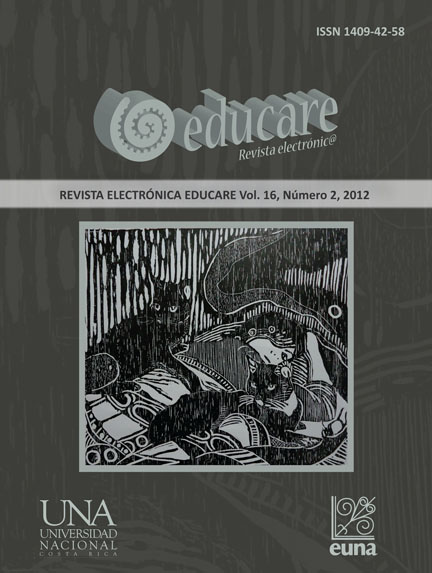The Butterfly Effect on Peace Education
DOI:
https://doi.org/10.15359/ree.16-2.12Keywords:
Education for peace, education, peace, butterfly effect, human right.Abstract
The objective of this paper on peace education is to generate a reflection, through the metaphor of the butterfly effect, on the importance of educating for peace during the change process of human beings and society. It proposes education for peace as a human right, an experience and learning process that is put into practice by human beings. It aims at changing attitudes and actions to create harmonious relationships based on the respect and recognition of human rights, and the freedom and dignity of every person.References
Briggs, J. y Peat, D. (1999). Las siete leyes del caos. Las ventajas de una vida caótica. Barcelona:
Grijalbo.
Caireta, M. y Barbeiro, C. (2005). “Introducción de conceptos: Paz, violencia, conflicto”. Cuadernos
de educación para la paz. Barcelona: Escola de cultura de pau (ECP). Recuperado de http://
escolapau.uab.cat/index.php?option=com_content&view=article&id=62&Itemid=92&lan
g=es
Cazau, P. (1995). La teoría del caos. Recuperado de www.antroposmoderno.com/antro-articulo.
php?id_articulo=152
Declaración de Luarca (Asturias) sobre el derecho humano a la paz. (2008). Revista de paz
y conflictos, 1, 109-119. Recuperado de http://www.ugr.es/~revpaz/numeros/numeros.
html#numero1
Gómez, M. E. (2010). “La Educación para la paz aplicada a la tutoría académica en la Facultad de
Ciencias Políticas y Sociales de la Universidad Autónoma del Estado de México”. Revista
Paz y Conflictos, 3, 2010, 123-139. Recuperado de http://www.ugr.es/~revpaz/tesinas/
rpc_n3_2010_dea3.pdf
Jares, X. (1999). Educación para la paz. Su teoría y su práctica (2a
ed.). Madrid: Popular.
Jares, X. (2004). Educar para la paz en tiempos difíciles. Bilbao: Bakeaz. Recuperado de http://ficheros.
bakeaz.org/SG14_completo.pdf
Lorenz, E. N. (2001). The essence of chaos [La esencia del caos] (4 ed.). (Apéndice 1, pp. 181-184).
Seattle: University of Washington Press.
Monclús, A., Sabán, C. (1999). Educación para la paz. Madrid: Editorial Síntesis.
Naciones Unidas. (1999). Resoluciones 53/243 de 6 de octubre de 1999. Declaración y programa de
acción sobre una cultura de paz. Recuperado de http://www.unesco.org/cpp/sp/proyectos/
suncofp.pdf
Naciones Unidas (s. f.). Declaración Universal de Derechos Humanos. Recuperada de http://www.
un.org/es/documents/udhr/
Real Academia Española (RAE). (2001). Diccionario de la Real Academia Española. Vigésima
segunda edición. Recuperado de http://buscon.rae.es/draeI/SrvltConsulta?TIPO_
BUS=3&LEMA=Hacer
Restrepo, M. (2011). Educación en derechos humanos y paz: La experiencia colombiana. En
UNESCO. IV Jornadas de Cooperación Iberoamericana sobre Educación para la Paz, la Convivencia Democrática y los Derechos Humanos (pp. 189-200). Santiago, Chile: OREALC/
UNESCO. Recuperado de http://unesdoc.unesco.org/images/0019/001916/191613s.pdf
Torres, C. (2007). Conceptualización y caracterización de la educación no formal. En C. Torres
y Pareja, J. A. (Coords.). La educación no formal y diferenciada: Fundamentos didácticos y
organizativos (pp. 11-38). España: CCS.
Downloads
Published
How to Cite
Issue
Section
License
1. In case the submitted paper is accepted for publication, the author(s) FREELY, COSTLESS, EXCLUSIVELY AND FOR AN INDEFINITE TERM transfer copyrights and patrimonial rights to Universidad Nacional (UNA, Costa Rica). For more details check the Originality Statement and Copyright Transfer Agreement
2. REUTILIZATION RIGHTS: UNA authorizes authors to use, for any purpose (among them selfarchiving or autoarchiving) and to publish in the Internet in any electronic site, the paper´'s final version, both approved and published (post print), as long as it is done with a non commercial purpose, does not generate derivates without previous consentment and recognizes both publisher's name and authorship.
3. The submission and possible publication of the paper in the Educare Electronic Journal is ruled by the Journal’s editorial policies, the institutional rules of Universidad Nacional and the laws of the Republic of Costa Rica. Additionally, any possible difference of opinion or future dispute shall be settled in accordance with the mechanisms of Alternative Dispute Resolution and the Costa Rican Jurisdiction.
4. In all cases, it is understood that the opinions issued are those of the authors and do not necessarily reflect the position and opinion of Educare, CIDE or Universidad Nacional, Costa Rica. It is also understood that, in the exercise of academic freedom, the authors have carried out a rogorous scientific-academic process of research, reflection and argumentation thar lays within the thematic scope of interest of the Journal.
5. The papers published by Educare Electronic Journal use a Creative Commons License:















 The articles published by Educare Electronic Journal can be shared with a Creative Commons License:
The articles published by Educare Electronic Journal can be shared with a Creative Commons License: 



